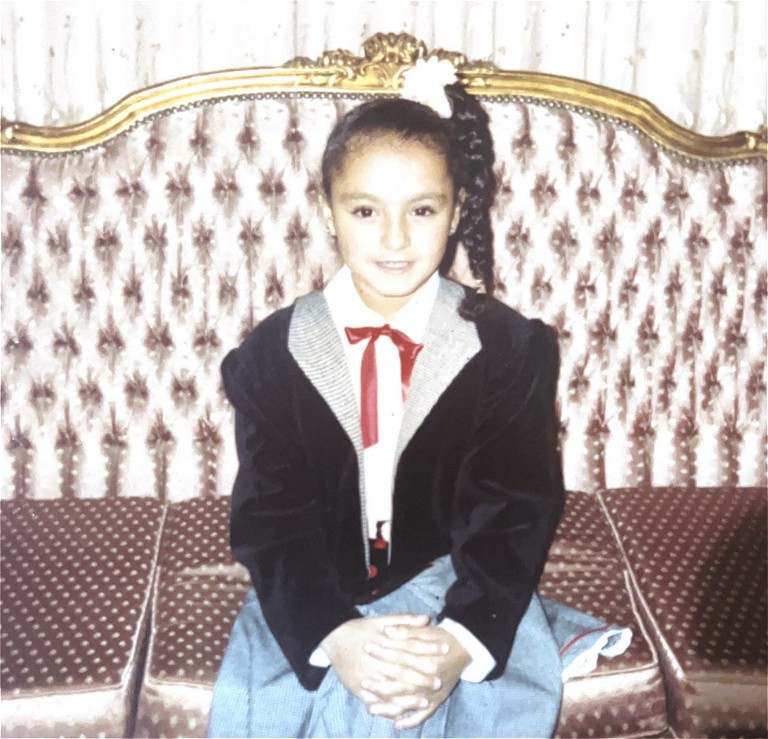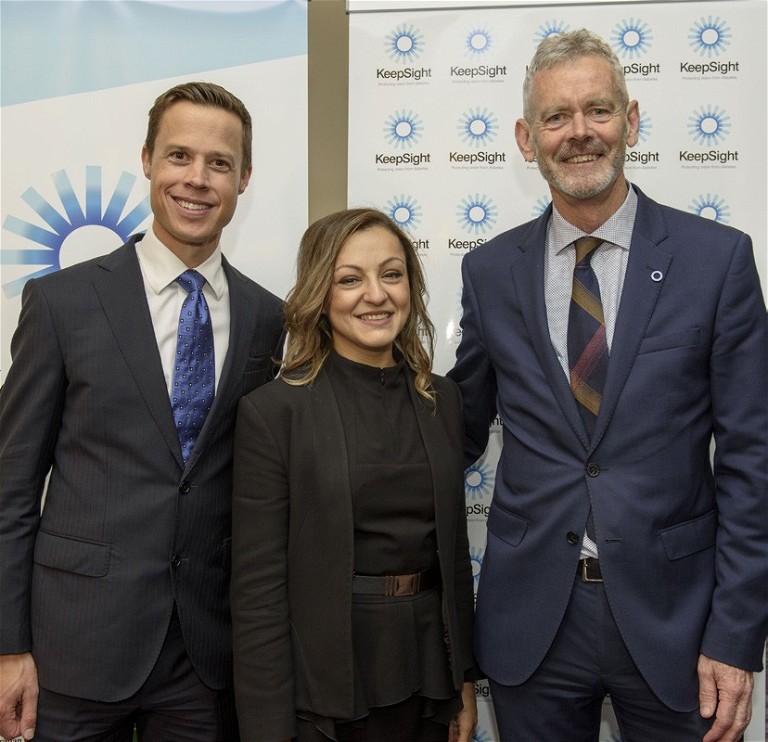mistory
Amira’s Story
WRITER Melanie Kell

Amira as a child.
Amira was just eight years old when she was diagnosed with diabetes type 1.
“It was during the school holidays, and naturally being eight, I indulged in snacks and sweets that were usually reserved for weekends and holiday breaks. Unfortunately, it didn’t take long before I fell ill,” she explained to mivision.
“That day Mum took me to our local GP and they ran some tests. Diabetes was mentioned but before we could receive the results, I ended up in hospital. By that time, I was dehydrated. I couldn’t walk and it turned out my blood glucose levels were extremely high.”
The mention of a possible diabetes diagnosis turned out to be Amira’s new reality.
Amira’s family knew little about diabetes and, having migrated to Australia from Egypt just four years prior, cultural and language barriers made coming to terms with the diagnosis harder.
“Medical care for people with diabetes in Egypt was different to that available in Australia back in the day. When the diagnosis was translated for them, they were concerned about my life expectancy, and for me it was all doom and gloom. Listening in, I thought it was a terminal illness.”
RAPID LEARNING CURVE
Amira spent several months in hospital recovering and during that time, learnt how to manage her new life with diabetes.
“I grew up very quickly and learned a lot around nutrition in a relatively short timeframe – from calculating carbohydrates and sugars to portions and calculating how much insulin to give per 15 grams of carbohydrates. I had to learn about the correlation between energy and carbohydrates versus sugars, and what role saturated versus unsaturated fats had on my meals,” she said.
“I recall my mother could not look at needles; it was one of the reasons she turned down studying medicine. Despite this, she overcame her fears in order to be shown how to draw up syringes and administer insulin injections. I recall both of us having to sit down with the diabetes educator as we learnt how to draw up the insulin from the vial, flick the bubbles up from the syringe, and push out the excess insulin. Never had I imagined I would be doing this at the age of eight,” she said.
Amira said it was a pivotal time for her mother.
“Our staples are rice and bread with every meal – often cooking with various oils and ghee. Overnight, mum made adjustments to what she cooked and how she cooked. Although in theory I could have continued eating the same meals, she wanted to make sure I could calculate my carbohydrates and that I was eating healthily. As such the entire family had a change in diet. They were on the journey with me.”
As a young teenager she said life became a little more complicated again as she navigated eating out with friends.
“It took time for me to tell my friends I had diabetes; for many years I preferred not to talk of it – I just wanted to fit in. But later, as my close circle of friends came to know and I found how supportive they were, I felt more comfortable sharing it with others. At times, it even allowed us to have a laugh, knowing I could bring jellybeans into the classroom. There were often times when a bag of jellybeans would makes its way around the room.”
Over the long term, Amira said the knowledge around nutrition and portion control paid off. Today, healthy eating comes naturally.
LIVING WITH DIABETIC RETINOPATHY
As an optometrist, Dr Amira Howari has long been aware of the ocular complications associated with diabetes, but no more so than when she became pregnant with her first and then second child.
“The moment I found out I was pregnant, I strictly controlled my blood glucose levels and started to have very regular eye work-ups.”
In those early days of her first pregnancy she was told she had signs of “very mild, non-proliferative diabetic retinopathy, which hadn’t been there before – a common finding when blood glucose levels are suddenly strictly managed”.
Without retinal cameras, she was unable to see the retinopathy for herself. However, during her second pregnancy, a few years later, she was able to see imaging of her own retinas.
“It was 2010 when the ultra-widefield retinal camera was launched in Australia. I was one of a select few optometrists invited to the showroom to learn how to use the technology and I won’t ever forget the impression it left. During the training course they said, ‘Would you like a scan done?’. And of course I said ‘yes’”.
“The scan enabled me to see, for the first time, almost my entire retina. And for me, that was a game changer. Looking at an ultra-widefield retinal scan is very different from looking into someone else’s eyes via fundoscopy or ophthalmoscopy. I could see far more of the periphery than I had ever seen before – and I could zoom in to see every micro aneurysm or haemorrhage.
“While I had an image in my mind of what it would look like, I was unprepared for how much laser had already been done to protect my vision.
“I sat there analysing it for so long. Being well aware of the progress of diabetic retinopathy, I remember thinking: if that’s what my retina looks like after a moderate amount of prophylactic PRP, then I had better get more proactive, otherwise I wouldn’t like where I was heading.”
Dr Howari said those first images, and every subsequent image, have reinforced the need to carefully manage her health and to undertake regular diabetes eye examinations with the same eye care professional where possible. They also shaped her approach to managing patients, and the messages she clearly articulates when speaking with them.
INFLUENCE ON PATIENT MANAGEMENT
“The two things that I stress to patients, in terms of eye examinations, are to have a regular optometrist, just as you have a regular GP or a cardiologist, and if you are going to be comanaged, to have consistency in the standard of eye care, the management expectation, and where possible, the equipment used,” she said.
“When it comes to visual fields assessments, we know that in ophthalmology, the gold standard is the Humphreys. And hence, we prefer using similar equipment for repeatability, reliability, consistency and comparability. For me, using the Optos for retinal scans is also important so that the sequence of images are comparable, consistent and repeatable. Early detection is key. To do this effectively we need to minimise variables when comparing scans over time.
“I will often send my patients to meet the ophthalmologist before they reach the point where treatment is indicated. Building trust and rapport like this is an essential factor for long-term treatment success.
“I’ve found that patients who meet the ophthalmologist for the first time on the day of their treatment of anti-VEGF (vascular endothelial growth factor) injections or pan-retinal photocoagulation (PRP), can potentially find the experience too confronting. With little rapport built previously, these patients may be at risk of falling through the gaps of the health care system as they are too afraid to go back for further treatment.
“In addition to this, I follow-up with patients referred for treatment post their session. This is where we can talk through any concerns they have, and if there is concern that they will not continue with the treatment course despite further education around the first line treatment chosen, I can liaise with the ophthalmologist and discuss alternate treatment options that may increase the chances of patient compliance.”
Dr Howari said registering patients with KeepSight, Diabetes Austtralia’s free program that encourages and reminds people living with diabetse to have regular eye examinations, is also integral to the care she provides.
“ I will often send my patients to meet the ophthalmologist before they reach the point where treatment is indicated ”
MAKING A DIFFERENCE
Now at 40 years of age, Dr Howari has lived with diabetes for 32 years.
“When you’ve had diabetes for over 10 years, especially type 1, there’s an 80% prognosis of developing diabetic retinopathy.
“The experience of living with diabetes and going through treatment for diabetic retinopathy, having had various treatments including PRP and anti-VEGF injections, has certainly highlighted the importance of compliance when it comes to regular optometric eye examinations, and ophthalmologist followups with regular retinal scans that can be shared and compared over time.
“My professional interest in diabetic eye disease and my personal lived experience have uniquely positioned me to have conversations with patients that delve deeper into diabetes, eye health and quality of life, which I hope will make a difference – not only to their long-term ocular health but also to their outlook on life and health as well.”

Dr Amira Howari supported the implementation of Diabetes Australia’s KeepSight program, which was initiated by ophthalmologist Professor Peter van Wijngaarden (left) and Greg Johnson from Diabetes Australia (right).